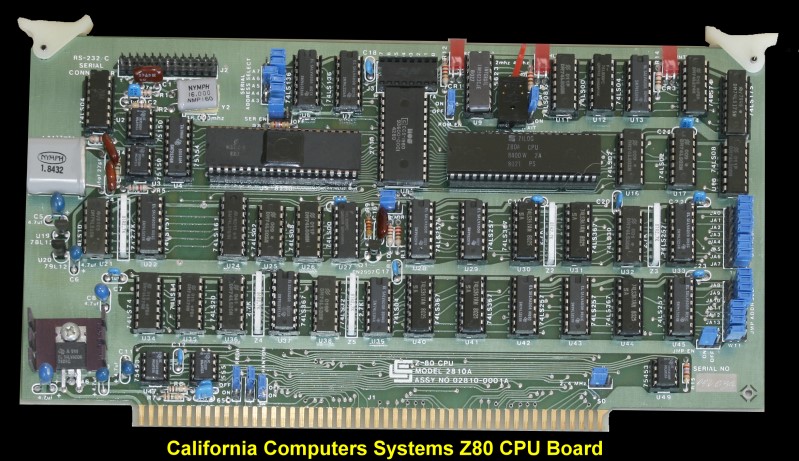
California Computer Systems -
2810 Z80 CPU Board
Being a late arrival on the S-100 bus
scene this board had some nice features others lacked.

The CPU could be run at 2 or 4 MHz
via the switch at the top of the board. Three diagnostic LEDs were provided
on the 2810. One indicated that the ROM was enabled and selected. The second
indicated that the CPU was executing a software Halt instruction and was waiting
for an interrupt. The third LED indicated that CPU had been programmed to accept
interrupts.
Since the Z80 would remain halted while
executing a Halt instruction (until the system is reset or the CPU receives an
interrupt), the last two LEDs could be used in combination to detect software
problems of the CPU receiving a Halt instruction before it receives an Interrupt
Enable instruction. Very useful!
The board contained an on-board,
asynchronous serial I/O port (using an 8250) which allowed you to interface to
the CPU any serial I/O device which conforms to a major subset of the RS-232-C
standards for asynchronous serial communications. You had several options in
using this port. If you were using the monitor firmware as is, you were provided
with driver routines for the port. These routines intend that the port be used
to interface the CPU to some type of console device, preferably a CRT. For
flexibility, the baud rate can be set through console control. Or you could, of
course, use your own driver software for the port. The port's address was
jumper-selectable. You could also disable the serial port with an on-board
jumper.
There was the usual power on jump to
the on-board EPRO routine of course. CCS used the boot address of F000H.
The onboard monitor looks to me to be very like the TDL Zapple monitor. The Z80
refresh signal was put out on pin 66.
The manual for this board can be
obtained
here.
Other California Computer
Systems S-100 Boards
16K RAM
2065 64K RAM
2066 64K RAM
FDC
Z80 CPU
SIO
Serial & Parallel
Other Boards
This page was last modified
on
01/08/2011


